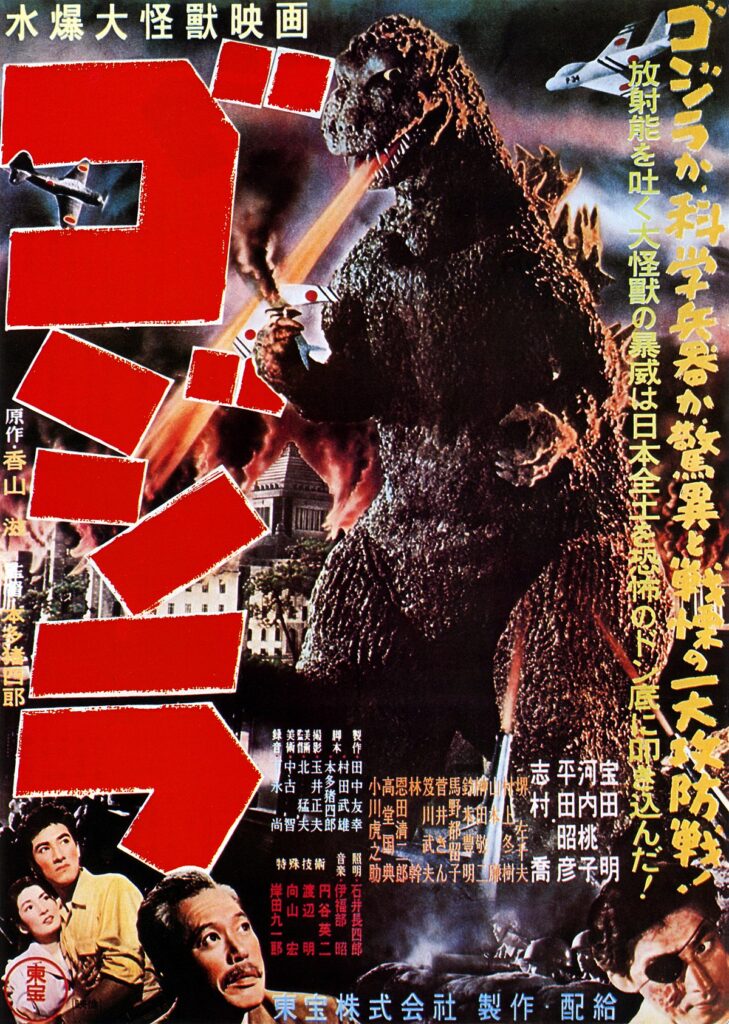
Japanese Godzilla Movie Posters: A Visual Feast!
Table of Contents
Lets know Japanese Godzilla Movie Posters, Who doesn’t love a good monster movie? And when it comes to monster movies, Godzilla is the king. Since his first appearance in 1954, Godzilla has stomped his way through cinema screens worldwide, leaving a lasting impression. But it’s not just the movies themselves that have captivated audiences—Godzilla movie posters have become iconic pieces of art. These posters are more than just advertisements; they are a visual feast that reflects the cultural and artistic trends of their times.
The Birth of Godzilla
Godzilla, or Gojira as he’s known in Japan, first emerged from the depths in 1954. Created by Tomoyuki Tanaka, Ishirō Honda, and Eiji Tsuburaya, Godzilla was a metaphor for nuclear destruction, a creature born from the horrors of atomic warfare. The first movie poster for “Gojira” (1954) set the tone for what was to come. It featured a menacing Godzilla towering over a burning city, capturing the essence of fear and awe that the film intended to convey.
Evolution of Japanese Godzilla Movie Posters
1950s: The Classic Era
The 1950s Godzilla posters were dramatic and intense. They focused on Godzilla’s destructive power, using dark, moody colors and stark imagery. These posters were designed to evoke a sense of dread and wonder, drawing audiences into the theaters.
1960s: Expanding the Monster Universe
As Godzilla’s universe expanded to include other monsters like Mothra and Rodan, the posters became more vibrant and action-packed. The 1960s posters often featured multiple creatures, hinting at epic battles and larger-than-life confrontations.
1970s: Godzilla in Pop Culture
The 1970s saw Godzilla becoming a pop culture icon. Posters from this era reflected a more colorful and sometimes campy aesthetic, appealing to a broader audience. They often featured dynamic compositions and bold typography.
1980s: A Return to Form
The 1980s marked a return to Godzilla’s darker roots. Posters from this decade revisited the intense and ominous themes of the original film, but with a modern twist. The use of shadows and dramatic lighting was prominent, creating a sense of mystery and foreboding.
1990s: Modernization and Nostalgia
In the 1990s, Godzilla posters balanced modernization with nostalgia. The artwork became more sophisticated, with detailed illustrations and a nod to the classic designs. This era’s posters often blended traditional painting techniques with digital enhancements.
2000s: Millennium Series and Beyond
The new millennium brought a fresh wave of Godzilla movies and with them, a new style of posters. These posters were sleek and modern, utilizing digital art to create highly detailed and dynamic images. They often highlighted the scale and power of Godzilla, appealing to a new generation of fans.
2010s: Reboots and Revivals
The 2010s saw several reboots and revivals of the Godzilla franchise. Posters from this era were highly polished, often using CGI to create hyper-realistic images of Godzilla. They focused on intense action scenes and dramatic compositions, emphasizing the epic nature of the films.
Famous Artists and Designers
Many talented artists and designers have contributed to the legacy of Godzilla posters. Notable names include Noriyoshi Ohrai, known for his detailed and dynamic compositions, and Akira Watanabe, who helped define the early visual style of Godzilla. The influence of traditional Japanese art, with its emphasis on dramatic landscapes and powerful imagery, can be seen in many of these works.
Cultural Significance of Godzilla Posters
Godzilla posters are more than just promotional tools; they are cultural artifacts. They reflect the societal changes and historical contexts of their times. For instance, the original 1954 poster captures the post-war anxieties of nuclear devastation, while later posters reflect the evolving entertainment landscape and changing audience tastes.
Collectibility and Market Value
The collectibility of Godzilla posters has surged in recent years. Original posters, especially those from the early films, can fetch high prices at auctions. Collectors value these posters for their historical significance and artistic quality. For those looking to start a collection, it’s essential to look for authentic, well-preserved pieces and to be aware of the market trends.
Comparison with International Posters
Godzilla’s global appeal means that there are numerous international posters, each with its unique style. Japanese posters tend to focus more on artistic elements and cultural themes, while international posters often emphasize action and spectacle. Comparing these different designs offers fascinating insights into how Godzilla is perceived around the world.
Modern Interpretations and Fan Art
In recent years, modern artists and fans have created their own interpretations of Godzilla posters. These works often blend traditional elements with contemporary styles, resulting in fresh and innovative takes on the classic imagery. Fan art plays a significant role in keeping the Godzilla legacy alive, showcasing the enduring popularity of the character.
Impact on Other Media
Godzilla’s influence extends beyond movies and posters. The iconic imagery has inspired comic books, video games, and a wide range of merchandise. Cross-media promotional posters often incorporate elements from these various formats, creating a cohesive visual identity for the Godzilla brand.
The Future of Godzilla Posters
With newJapanese Godzilla Movie Posters on the horizon, the future of Godzilla posters looks bright. Upcoming trends may include more digital art and interactive posters, blending traditional techniques with modern technology. As the film industry evolves, so too will the art of movie poster design, ensuring that Godzilla remains a visual icon for generations to come.
Conclusion
Japanese Godzilla Movie Posters are a visual feast that has captivated audiences for decades. From their dramatic beginnings in the 1950s to the sleek, modern designs of today, these posters reflect the evolution of both the character and the film industry. They are cultural artifacts, artistic masterpieces, and collector’s treasures. As we look to the future, the legacy of Godzilla posters will undoubtedly continue to inspire and entertain.